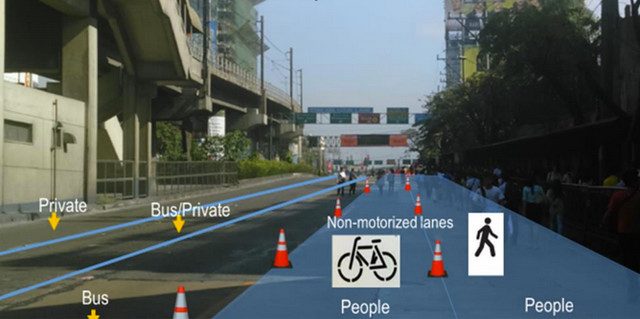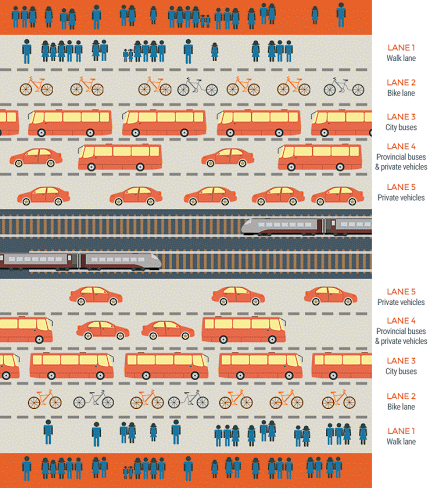SUMMARY
This is AI generated summarization, which may have errors. For context, always refer to the full article.

MANILA, Philippines – Another revolution is set to take place on Epifanio Delos Santos Avenue (EDSA) on Sunday, June 28.
For the first time ever, Metro Manila’s main thoroughfare will become a shared road, with one half of both its north- and south-bound lanes devoted to pedestrians and bikers, and the other half for vehicles.
The Metro Manila Development Authority (MMDA) announced on Monday, June 22, that this road-sharing will take place from 12 am to 11:59 pm on Sunday.
Only one portion of EDSA will follow the road-sharing scheme – the area from Ortigas to SM Mall of Asia in Pasay. The halving of the roads will be implemented on both the south-bound and north-bound lanes.
Each EDSA lane is composed of 5 smaller lanes. They will be divided as follows:
Lane 1 (lane closest to existing sidewalks) – Walk lane
Lane 2 – Bike lane
Lane 3 – City buses
Lane 4 – Provincial buses and private vehicles
Lane 5 – Private vehicles

The aim of the road-sharing scheme is to introduce a transportation system with a reduced number of private cars, said renowned environmental lawyer Antonio Oposa Jr, the mastermind behind the Share the Road movement.
“Why is there traffic? Because we have too many cars. The whole point of this exercise is to improve transportation using existing resources,” he said during the press conference.
Heroism on the road
Road-sharing, he says, is an exercise of the “Bayanihan sa Daan” principle in which the road becomes a venue for people to practice cooperative heroism.
The overall goal of the movement is to improve traffic in Philippine cities. The hope is that an equally distributed road will encourage more people to walk or bike, lessening the number of cars on the road.
Less than 1% of Filipinos own cars, says Oposa, yet they are given a lion’s share of the road. Pedestrians, meanwhile, make do with tiny, often rutted, sidewalks. Bikers too have to make the most of bike lanes not respected by all motorists.
With one half of each of the lanes devoid of cars, pedestrians and bikers are given a wider space.
“I have full support for this program, for any effort to clean our air, improve health of our citizens, and ease traffic,” said MMDA Chairman Francis Tolentino.
He said this was only a “proof of concept” and trial, “so we can see what will happen, if it will work.”
But the share-the-road scheme has also been criticized for doing the exact opposite – aggravating traffic woes.
When a similar event was held on Osmeña Boulevard in Cebu City, it was badly received by private car drivers and jeepney drivers who had to endure traffic jams caused by road closures.
But Oposa says the congestion was due to a lack of communication, not the road exercise itself.
He appealed to private car drivers to take an alternative route since they will only be given only 2 out of 5 lanes on EDSA.
“This isn’t going to be perfect. There will be complaints. But as an exercise, practice makes perfect. If you do this in EDSA, you can do this anywhere in the Philippines and the world,” said Oposa.
He also encouraged private car owners to take public transportation on that day instead.
“The whole point is to challenge the mentality that cars should be the primary form of transportation,” he said.
Tolentino admitted that the MMDA still has no alternative traffic plans given the limited space for cars on EDSA on Sunday. But his agency is set to make announcements soon.
Cooperation from buses
Critical to the success of the road-sharing exercise is the support of the city and provincial bus operators.
Buses on EDSA contribute to heavy traffic. Flaire Benito of the Integrated Bus Operators Association (INTERBOA) admits that city buses unload passengers outside official bus stops because “passengers get angry waiting,” she said in Filipino.
But for Sunday’s event, she said city buses promise to stop only in the 8 official bus stops along the route.
“The buses will not open their doors until the official bus stops,” she said.
Provincial bus operators are also on board.
“From June 28, 12:01 am to 11:59 pm, provincial buses will be assigned the 4th lane. We will advise our member bus operators and drivers. But hope MMDA can inform bus operators who are not members of our group,” said Provincial Bus Operators Association of the Philippines (PBOAP) Executive Director Alex Yague.
PBOAP members include major bus lines Victory Liner, Five Star, Ceres, DLTB, Jam, and Philtranco, among others.
Around 3,500 provincial buses go in an out of EDSA on Sundays, only half of the number of buses traveling on weekdays.
The road-sharing scheme will affect buses that have terminals in Pasay and Ortigas. Terminals in Cubao, Kamuning, and Kamias will not be affected, said Yague.
But Edmund Parungao, chief inspector of city busline Nova, raised his concern with city buses letting off passengers on the bike lane, the lane right beside the lane assigned to city buses.
He requested the MMDA to ensure a smooth and safe process for doing this.
Another cause for concern is the area called Mantrade on Magallanes Avenue coming from the South Luzon Expressway where provincial and city buses converge.
“The way the buses converge should be monitored so that the buses go to their assigned lanes,” he said.
Transport transformation
Biking groups expressed support for what they call an “EDSA Evolution.”
“One of our wishes is for the Philippines to be bike-friendly. What we are doing on Sunday is one big step towards the fulfillment of that dream, to have bike lanes. Not just in any road but in EDSA,” said Rosar Crisostomo of the National Bicycle Organization.
Oposa and the agency heads know road-sharing may seem radical for most people. The challenge is to scale the scheme up gradually.
“People will be angry. But that just shows how car-centric our roads have become. We are all part of the problem. But rather than complain, let’s do something about it. EDSA has already hit rock-bottom, it’s a parking lot. Let’s change things,” said Karen Crisostomo of the National Bicycle Organizaiton.
If the Sunday road-sharing experiment proves a success, it can be repeated on succeeding Sundays. One day, Oposa hopes the exercise can be done on entire weekends.
This is not the first time road-sharing will be held on a major road.
Such a scheme has already been implemented in roads in Cebu City, Iloilo City, Pasig City, San Juan City, and another prominent Metro Manila road – Roxas Boulevard.
By halving roads, Oposa and the government agencies hope to reduce air pollution in Metro Manila.
Around 80% of air pollution in the mega city comes from vehicles, according to the Department of Environment and Natural Resources (DENR).
Weaning people from cars and encouraging them to take non-motorized forms of transportation is also the DENR’s strategy.
In November 2014, the agency introduced a Department Administrative Order requiring a one-meter sidewalk and one-meter bike lane in all new road projects in the country.
The MMDA, meanwhile, has its borrow-a-bike program, allowing commuters to ride MMDA bikes to bike stations scattered all over the metro. – Rappler.com
Add a comment
How does this make you feel?
There are no comments yet. Add your comment to start the conversation.